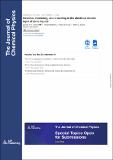Gelation, clustering, and crowding in the electrical double layer of ionic liquids
Author(s)
Goodwin, Zachary AH; McEldrew, Michael; Pedro de Souza, J; Bazant, Martin Z; Kornyshev, Alexei A
DownloadPublished version (5.355Mb)
Publisher with Creative Commons License
Publisher with Creative Commons License
Creative Commons Attribution
Terms of use
Metadata
Show full item recordAbstract
Understanding the bulk and interfacial properties of super-concentrated electrolytes, such as ionic liquids (ILs), has attracted significant attention lately for their promising applications in supercapacitors and batteries. Recently, McEldrew et al. [J. Phys. Chem. B 125, 2677 (2021)] developed a theory for reversible ion associations in bulk ILs, which accounted for the formation of all possible (Cayley tree) clusters and a percolating ionic network (gel). Here, we adopt and develop this approach to understand the associations of ILs in the electrical double layer at electrified interfaces. With increasing charge of the electrode, the theory predicts a transition from a regime dominated by a gelled or clustered state to a crowding regime dominated by free ions. This transition from gelation to crowding is conceptually similar to the overscreening to crowding transition.
Date issued
2022-09-07Department
Massachusetts Institute of Technology. Department of Chemical Engineering; Massachusetts Institute of Technology. Department of MathematicsJournal
The Journal of Chemical Physics
Publisher
AIP Publishing
Citation
Zachary A. H. Goodwin, Michael McEldrew, J. Pedro de Souza, Martin Z. Bazant, Alexei A. Kornyshev; Gelation, clustering, and crowding in the electrical double layer of ionic liquids. J. Chem. Phys. 7 September 2022; 157 (9)